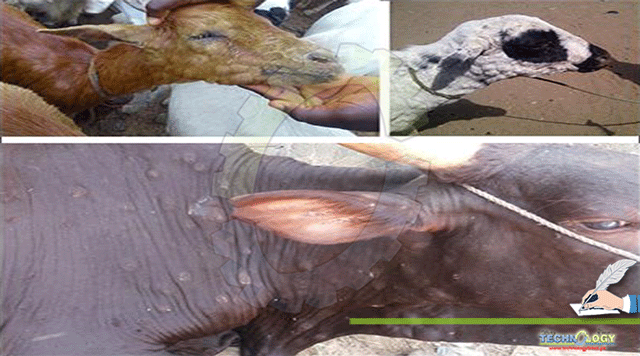Lumpy skin disease is a severe disease of cattle (Bos indicus and Bos taurus) and buffaloes (Bubalus bubalis), caused by Neethling pox virus (Capripox-virus).

By Dr. Rana Muhammad Athar Ali,Dr. Mughees Aizaz Alvi,Dr. Ghulam Muhammad,Dr. Muhammad Saqib
Introduction
Bos taurus is more vulnerable to this disease as compared with Bos indicus. This virus does not infect humans. It falls in the same genus as that of sheep and goat pox virus. The World Organization for Animal Health (OIE) categorized it as reportable disease due to its impacts on economy. The mortality rate is low, but the disease causes serious production losses. It is responsible for reduced feed intake, milk production, body condition score (BCS), fertility and abortion in cows.
Epidemiology
Disease was confined to sub-Saharan Africa, then spread to many African countries in 1970s, Egypt (1988 and 2006), and Israel (1989, 2006-2007, and 2012). In Israel, it was eradicated by slaughtering of the animals. In the Middle East, cases confirmed in Kuwait (1991), UAE (2000), Oman (2010), Jordan and Iran (2013). It may be introduced into European countries through illegal movement of animals. Since 2015, cases have been reported from Russia, Greece, Azerbaijan, Bulgaria, Armenia, Kosovo, Serbia, Albania, Kosovo, and India. A word of mouth reports from various parts of the country would indicate that the disease has recently ingressed into Pakistan.

Figure 1. Worldwide distribution of lumpy skin disease.
Origin and transmission
The shedding of virus occurs in lacrimal and nasal secretions, semen and milk of the infected animals. There is less risk through direct contact and transmission mostly occurs through vectors. Virus was detected in bitting flies (Biomyia fasciata), mosquitoes (Aedes natrionus and Culex mirificens), and ticks (Amblyomma and Rhipicephalus spp.) but transmission was not observed when they were allowed to feed on cattle. Experimental transmission through semen have been reported.

Figure 2. Short and long routes of transmission
Risk Factors
All types of cattle are susceptible. Lactating, weak, and young animals develop more severe disease as compared with healthy, robust, and mature animals. Cases have not been identified in wild animals and they may be considered as reservoir hosts. Experimentally infected sheep and goat develop the skin lesions, but no systematic signs were reported. Outbreaks were linked with high arthropod activity and rain fall. Capripox-virus is resistant to freezing, and thawing.
Pathogenesis and Clinical Presentation
Incubation period varies from 2 to 4 weeks in case of natural infection. Initially there is rise in body temperature which lasts for a period of one week followed by nasal discharge, lacrimation, salivation, and lameness. Intradermal nodules begin to develop on entire body. Mostly nodules grow on entire skin but in some cases, they may develop in nostrils and turbinates and may cause snoring and nasal obstruction. Later, nodules disappear rapidly with few exceptions, where they persist as hard lumps.

Figure 3. Nodule formation on skin in LSD.
Differential Diagnosis
Pseudo-Lumpy Skin Disease
It is caused by bovine herpes virus-2 or bovine mammalitis virus and is characterized by circular necrotic lesions with central area of scab. The scab falls off later, leaving depigmented hairless areas. It is also known as Allerton disease or Gulwaddee. The disease lasts for as long as 14 days and no mortality is reported.
Treatment
There is no specific treatment for this disease. Antibiotics must be given to avoid secondary bacterial infection such as sulfonamide.
Prevention and Control
Following measures must be implemented to limit the virus dissemination:
Vaccination
Antigens of Capripox-virus has similarity with sheep-poxvirus. Therefore, attenuated Sheeppox-virus can be used to modulate the immune system of host against LSD. These live, attenuated vaccines contain a living microbe that has been weakened in the laboratory so it can not induce the disease. Infectious microbes can stimulate generation of memory cellular as well as humoral immune responses. This vaccine cannot be administered to immunosuppressed and malnourished animals.
Vector Control
Vector traps (light and adhesive traps) and acaricides (pyrethroids, organophosphates and carbamates etc.) can be used to prevent disease transmission.
Biosecurity
- Infected animals must be isolated and inspected to limit the spread of disease.
- Quarantine of newly purchased animals.
- Restricting the movement of infected animals.
- Culling of infected animals.
Authors:
Dr. Rana Muhammad Athar Ali, M.phil. Clinical Medicine and Surgery, University of Agriculture, Faisalabad.
Dr. Mughees Aizaz Alvi, Lecturer Clinical Medicine and Surgery, University of Agriculture, Faisalabad.
Dr. Ghulam Muhammad, Retd. Professor Dept. of Clinical Medicine and Surgery, University of Agriculture, Faisalabad.
Dr. Muhammad Saqib, Chairman Dept. of Clinical Medicine and Surgery, University of Agriculture, Faisalabad.
Further Reading
OIE Terrestrial Manual, Chapter 2.4.14. Lumpy skin disease. Accessed at: <http://www.oie.int/fileadmin/ Home/eng/Animal_Health_in_the_World/docs/pdf/ Disease_cards/LUMPY_SKIN_DISEASE_FINAL. pdf> Accessed July 16, 2016.
Tuppurainen ESM, Oura CAL. Review: lumpy skin disease: an emerging threat to Europe, the Middle East and Asia. Transbound Emerg Dis. 2012;59:40-48.